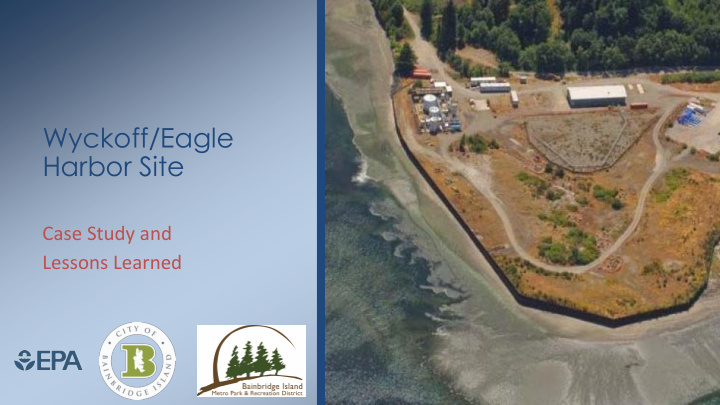



Wyckoff/Eagle Harbor Site Case Study and Lessons Learned
Topics for Today • Brief Site History – Cleanup Actions to Date – Redevelopment Actions to Date • Reuse Planning Process • Reuse Outcomes • Additional Cleanup Actions Proposed • Lessons Learned • Questions 2
Site Location 3
Suquamish Tribe Village on Eagle Harbor - Early 1900s 4
Cleanup History • Added to the Superfund list in 1987 • Contamination found in upland soils and groundwater, and in Eagle Harbor sediments • Two primary sources of contamination – Wyckoff wood treating facility – Former shipyard • Extensive cleanup actions implemented between 1993 and 2008 5
Site Overview 6
Site History Wood treating facility 1940s 7
Cleanup Actions to date: Upland • Demolition and removal of buildings, chemical storage tanks, grossly contaminated surface soils • Perimeter sheet pile wall • Groundwater extraction and treatment system (wells, treatment plant) • Fencing, signage to prevent exposure to soils 8
Current Site Conditions 9
Cleanup Actions to date: Offshore • Sediment cap over 70 acres of Eagle Harbor – Built in phases 1993 - 2001 • West Beach – Wooden bulkhead demolished – Contaminated soils removed – Exposure Barrier System built in 2008 • Extensive cap repair 2017 10
Sediment Cap in Eagle Harbor 11
Former bulkhead along West Beach 12
West Beach Today 13
Redevelopment Actions to Date • Property purchased by the City and Bainbridge Island Metro Parks park in early 2000s • Trails constructed, signage posted • View Point looking across Puget Sound • Bainbridge Island Japanese American Exclusion Memorial constructed on western end of Park 14
Major Steps to Park Development • Planning group that focused on acquiring the property, Wyckoff Advisory Committee • Acquisition – in several phases: 2004 – 2006. – EPA Pilot Project Grant – Pre-purchaser Agreement, Justice Department Covenant and Agreed Order – Grants and Funding Partners, Trust for Public Land and BILT • Development of trails • Site Design: City – Parks Advisory Design Committee – University of Washington • Memorial, First Phase Development. 15
Joel Pritchard/Japanese American Memorial Park Project 16
17
Site Plan Allows for Future Adaptation of the Point – Next Phase of Clean-up 18
Pritchard Park Plan Accentuates Location 19
Restored Beach Satisfies Local Needs 20
Point 21
Upland Trails: Provides for Recreation Demand 22
Shoreline and Trail Interface 23
Nidoto Nai Yoni ͞Let it not happen again͟ • On March 30, 1942 the federal government through Executive Order 9066 gave authority to the War Department to remove what would total over 110,000 persons of Japanese ancestry from the west coast. • The first 227 of these residents came from Bainbridge Island. 24
Memorial Planning with NPS and Local Partners 25
Memorial Planning with NPS and Local Partners 26
The Plan Provides for Interpretation of Pivotal Events for the Nation and the Community: Japanese American Internment 27
28
29
Joel Pritchard/Japanese American Memorial Park Project 30
Park Planning Process: Lessons Learned • Know the local setting -- its landscape, history and people. Something has happened here prior to Superfund status. • !nswer the What, Who and When/ not Just Where and How. • Develop the intellectual infrastructure and patience for decision-makers; a plan discusses site constraints but points the direction forward toward future opportunities. • Superfund Site status will represent more than a clean-up to a community when related to the human history of place; prior and future endeavors; and seeks to re-instill a sense of dignity. 31
More Cleanup Work is Needed • In the Upland portion of the site – Perimeter wall is corroding – Groundwater extraction & treatment system is expensive, will require >100 years of operations • On the East Beach and North Shoal: – Seeps of creosote remain on the beaches – Beaches are closed to shellfish harvesting • Additional cleanup actions proposed in 2016 – EPA and Bainbridge Island Metro Parks will continue to coordinate as cleanup plans are developed 32
To Learn More • Community re-use plan: – http://www.bainbridgewa.gov/574/Pritchard-Park-Design-Recommendations • Fact sheets and technical documents about the cleanup: – http://www.epa.gov/superfund/wyckoff-eagle-harbor • Pritchard Park: – https://biparks.org/parks-trails-finder/ • Japanese American Exclusion Memorial: – http://bijaema.org/ • Site reuse case study: – https://www.epa.gov/superfund-redevelopment-initiative/depth-case-studies-superfund-reuse 33
34
Recommend
More recommend